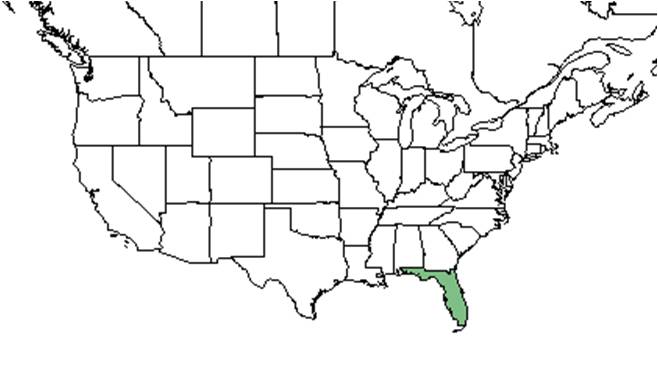Difference between revisions of "Cuthbertia ornata"
| Line 34: | Line 34: | ||
==Ecology== | ==Ecology== | ||
===Habitat=== <!--Natural communities, human disturbed habitats, topography, hydrology, soils, light, fire regime requirements for removal of competition, etc.--> | ===Habitat=== <!--Natural communities, human disturbed habitats, topography, hydrology, soils, light, fire regime requirements for removal of competition, etc.--> | ||
| − | ''C. ornata'' is endemic to the Florida peninsula and can be found in sandhills, palmetto-wiregrass scrubs, sandscrub, oak scrub, and flatwoods.<ref> | + | ''C. ornata'' is endemic to the Florida peninsula and can be found in sandhills, palmetto-wiregrass scrubs, sandscrub, oak scrub, and flatwoods.<ref>Archbold Biological Station accessed using Southeastern Regional Network of Expertise and Collections (SERNEC) data portal. URL: http://sernecportal.org/portal/collections/index.php Last accessed: May 2021. Collectors: L.J. Brass. States and Counties: Florida: Highlands.</ref><ref>Archbold Biological Station accessed using Southeastern Regional Network of Expertise and Collections (SERNEC) data portal. URL: http://sernecportal.org/portal/collections/index.php Last accessed: May 2021. Collectors: Vander Kloet. States and Counties: Florida: Highlands.</ref> It is also found in disturbed areas such as sandy roadsides.<ref name="Native">[[http://hawthornhillwildflowers.blogspot.com/2013/06/florida-scrub-roseling-callisia-ornata.htm Native Florida Wildflowers]] Accessed December 3, 2015</ref><ref name="eol">[[http://eol.org/pages/1125140/overview Encyclopedia of Life]] Accessed December 3, 2015</ref> |
===Phenology=== <!--Timing off flowering, fruiting, seed dispersal, and environmental triggers. Cite PanFlora website if appropriate: http://www.gilnelson.com/PanFlora/ --> | ===Phenology=== <!--Timing off flowering, fruiting, seed dispersal, and environmental triggers. Cite PanFlora website if appropriate: http://www.gilnelson.com/PanFlora/ --> | ||
Revision as of 09:52, 20 May 2021
| Cuthbertia ornata | |
|---|---|

| |
| Photo by Wayne Matchett above is of Callisia ornata (accepted synonym), SpaceCoastWildflowers.com | |
| Scientific classification | |
| Kingdom: | Plantae |
| Division: | Magnoliophyta - Flowering plants |
| Class: | Liliopsida – Monocotyledons |
| Order: | Commelinales |
| Family: | Commelinaceae |
| Genus: | Cuthbertia |
| Species: | C. ornata |
| Binomial name | |
| Cuthbertia ornata (Small) G. Tucker | |

| |
| Natural range of Cuthbertia ornata from USDA NRCS Plants Database. | |
Common name: Florida scrub roseling
Contents
Taxonomic notes
Synonyms: Callisia ornata (Small) G. Tucker; Tradescantia rosea Ventenat var. ornata (Small) E.S. Anderson & Woodson.[1]
Varieties: none.[1]
Description
A description of Cuthbertia ornata is provided in The Flora of North America.
C. ornata is an annual plant with linear blades and a stalk that can reach up to 12 inches high.[2][3] It can be identified by having thin, grass-like leaves along the stem and a flower scape that is held above the nearest leaves.[2]
Distribution
Ecology
Habitat
C. ornata is endemic to the Florida peninsula and can be found in sandhills, palmetto-wiregrass scrubs, sandscrub, oak scrub, and flatwoods.[4][5] It is also found in disturbed areas such as sandy roadsides.[2][3]
Phenology
Flowers are pink, ephemeral, bisexual, and radially symmetrical (Lakela 1972); usually blooming late summer and early fall.[2]
Seed dispersal
In late summer and early fall the ripened seeds can be found scattered below the parent.[2]
Pollination
The following Hymenoptera families and species were observed visiting flowers of Cuthbertia ornata at Archbold Biological Station: [6]
Halictidae: Augochlorella gratiosa
Conservation and management
Cultivation and restoration
Photo Gallery
References and notes
- ↑ 1.0 1.1 Weakley, A.S. 2015. Flora of the southern and mid-atlantic states. Working Draft of 21 May 2015. University of North Carolina at Chapel Hill, Chapel Hill, North Carolina.
- ↑ 2.0 2.1 2.2 2.3 2.4 [Native Florida Wildflowers] Accessed December 3, 2015
- ↑ 3.0 3.1 [Encyclopedia of Life] Accessed December 3, 2015
- ↑ Archbold Biological Station accessed using Southeastern Regional Network of Expertise and Collections (SERNEC) data portal. URL: http://sernecportal.org/portal/collections/index.php Last accessed: May 2021. Collectors: L.J. Brass. States and Counties: Florida: Highlands.
- ↑ Archbold Biological Station accessed using Southeastern Regional Network of Expertise and Collections (SERNEC) data portal. URL: http://sernecportal.org/portal/collections/index.php Last accessed: May 2021. Collectors: Vander Kloet. States and Counties: Florida: Highlands.
- ↑ Deyrup, M.A. 2015. Database of observations of Hymenoptera visitations to flowers of plants on Archbold Biological Station, Florida, USA.